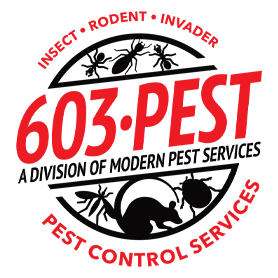Call Today: 603-210-2773
Or Request More Info.
"*" indicates required fields
Rat Pest Control
Rat Control Service Overview
603 Pest Control has the most effective programs and answers to the problem of how to get rid of rats.
If you suspect that rats are infesting your residence or workplace property, you can depend on our pest control expertise, and proven interior and exterior rodent programs.
Rat Pest Control Solutions
While mice tend to be curious about their surroundings, rats are neophobic – which means they are aware of and careful about new objects in their territory. This important distinction affects the process by which 603 Pest Control specialists execute our rat control programs.
The steps of the proven 603 Pest Control rat and rodent control process are:
- Perform a thorough pest inspection to thoroughly identify areas of rat infestation
- Seal all entry ways into home or building from foundation to attic
- Place and set multiple appropriately-sized traps in targeted interior areas to kill rats
- Return in two weeks to remove traps and dead rats
How to Identify Rat ActivityAround Your Home or Property
The Norway rat is New England’s most common and prevalent rat. It is typically brown, with a blunt nose, small eyes, and small ears covered with short hairs that don’t reach its eyes. Its tail is smaller than a mouse tail, and is shorter than the combined length of the head and body.
The difference between a young rat and an adult mouse is that a young rat has large eyes and large feet, while a house mouse has small eyes and small feet.
All rodents burrow and create tunnels. Even though they are good climbers, rats tend to stay on the lower floors or in the basement, not in the attic.
Key signs that confirm rat activity include:
- You see them or their fecal droppings, inside or outside your home or building.
- You see rat droppings, which are larger than mice droppings and blunt at both ends; bright and shiny if recently excreted; or dull and crumbly if not recent.
- You smell the bad odor of rat urine.
- You see large holes where rats have burrowed on the lawn outside near the foundation of your home or building, around chicken coops, sheds, and other structures.
Disease and Property Damage that Rats Can Cause
The fleas on rats can carry diseases such as Rat Bite Fever and the infamous Bubonic Plague. As with mice droppings, rat droppings and urine can carry disease and allergens. They can contaminate surfaces, food and water with Salmonella (the colorless, odorless and tasteless bacteria that leads to salmonellosis) or illness that can lead to stomach upset, intestinal pain and cramps, diarrhea and fever.
Rats and their droppings should be removed by a pest control professional who can properly sanitize the area and develop a plan to eradicate the rat infestation.
Rat Biology
Female rats typically give birth to four to seven litters per year, and may successfully wean 20 or more pups annually. Male rats are called bucks, unmated females are called does, pregnant or parent females are called dams, and infants are called kittens or pups. Appropriately, a group is referred to as a mischief. Rats are opportunistic, often raiding human food supplies and settling into areas with a consistent food supply. Rats can live for about a year.

